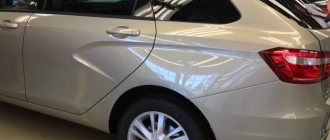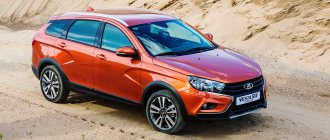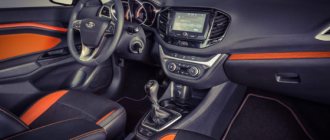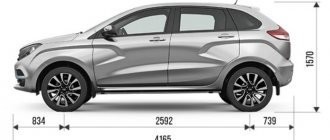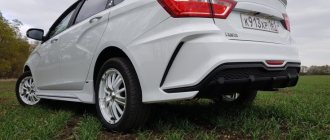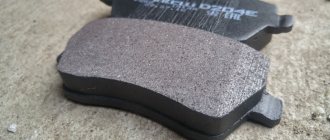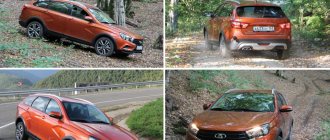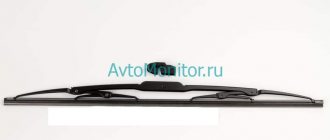Reading time: 7 minutes
Since 2015, a fundamentally new project of the AvtoVAZ concern called Lada Vesta has become available to Russian car enthusiasts. Considering the presentable appearance, modern powerful power units for this class with a volume of 1.6 or 1.8 liters, automatic transmission and other comfortable options, this vehicle has become the best-selling domestic car.
The plant’s engineers did not stop there; since the end of 2017, a unique modification of the brand has been released - the Lada Vesta SW Cross, which is a cross between a station wagon and a compact crossover and is a comfortable family car capable of driving on light off-road conditions in the winter.
Standard factory tires for Lada Vesta SW Cross
Winter tires on SW Cross
The developers tried to achieve a crossover effect from the standard wheelbase of this car. Winter tires on the Lada Vesta SV Cross can only be installed in 17-inch sizes, since these are the wheels that allow you to achieve a maximum ground clearance of 203 mm. The SV Cross modifications are coming off the assembly lines of automakers, having the following basic characteristics of tires installed in the standard version only for use in the summer:
- If we consider only geometric parameters, then the wheels for this modification of the Lada have the same size - 205/50/R17, which allows the car to have a decent appearance, overcome difficult sections of the road, and also not get stuck on soft ground thanks to the wide sole with powerful treads.
- When choosing winter tires for the Lada Vesta SW Cross, drivers should remember that most of these wheels are produced in an all-season version. If they need to choose a good friction or studded tire, they should still change the wheel to R16, since a 55-60 mm side cord is much more reliable when driving on rough terrain in the cold season.
- When a driver operates his car exclusively in a big city, he may well use all-season tires.
- Vesta Cross tire sizes do not offer drivers a rich assortment due to the specific technical characteristics of the vehicle. Absolutely all tires installed as standard on this modification of Vesta have special indexes.
On the profile of the Vesta SV Cross tire you can find the abbreviation M + S, which means Mud and Snow, and translated into Russian - “dirt” and “snow”. This designation does not mean that the tire has excellent grip on the road surface at temperatures below 0 degrees Celsius, but the treads are designed in such a way that the tire has traction properties on almost any surface down to -10 degrees.
Winter tires for Lada Vesta SW Cross
- The last important point when choosing tires for a given car is the shi indices. Considering the model’s ability to overcome areas with poor road quality, as well as the ability to accelerate to a speed of 190 km/h, these parameters in the factory version vary from 89V to 93W. These figures mean that when inflated, each wheel can withstand a load of up to 580-650 kg, and you can safely drive in this state at a speed of 240-270 km/h for at least 30 minutes without the risk of dismantling.
Top 5. KAMA Breeze
Rating (2021): 4.16
127 reviews from resources taken into account: Yandex.Market, Mosavtoshina
Best price KAMA Breeze is the most affordable summer tire in the ranking. The closest competitor, the Belarusian Belshina Artmotion tire, costs 12% more.
- Characteristics
Price: 2350 rub.
- Country Russia
- Load: 475-670 kg
- Speed: 190-210 km/h
- Tread pattern: symmetrical
When choosing summer tires for Lada, many owners prefer the KAMA Breeze model due to its affordable price. In general, the tire meets all expectations and does not have outstanding characteristics. There is moderate noise, good maneuverability and undemanding behavior on the road surface. The model's tread pattern demonstrates excellent road grip and high speed characteristics. Rubber provides directional stability on dry and wet asphalt. Reviews about the rapid wear of KAMA tires vary - sometimes there is an obvious defect.
Advantages and disadvantages
- Low price
- Predictable braking
- Good overclocking
- Marriage meets
How to choose the right winter tires for Lada Vesta SW Cross
- If the driver drives his Lada exclusively in the city, then the all-season M + S version with hard treads that will not wear out quickly during sharp braking or when turning on asphalt surfaces will suit him.
- When the vehicle is operated on country roads, or in the region where the driver lives, the air temperature often drops below -10 degrees Celsius, then it is simply impossible to do without full-fledged winter tires. And it’s even better if it is equipped with multi-directional metal spikes, which will ensure the stability of the car during acceleration, braking and cornering.
- If the car is planned to be used on rough terrain with completely snowy roads, then a studded tire will be unnecessary, because the studs play virtually no role in traction, and the main function is taken over by the soft tread. Thus, a car enthusiast should purchase a friction tire, the surface of which is cut into numerous lamellas with sharp edges.
Friction tires on Lada Vesta SW Cross
These elements, when pressed on them under the weight of the car, move apart, forming dozens of cracks, into each of which snow mass falls, lingering there for a certain time.
If excess moisture forms under the wheels (for example, at zero temperature outside the window, when the snow turns into mush), then it is effectively removed through special grooves for collecting water between the blocks of lamellas.
- When choosing wheels, a car enthusiast can turn not only to companies that are authorized brands of the concern, but also to other brands whose products are adapted for normal use in the middle zone. This means that the chemical composition of the rubber must be selected in such a way that the protectors do not harden even at extremely low temperatures.
It is advisable to select tires that contain admixtures of silicate materials and create an abrasive surface during wear. The most popular brands for Russian car enthusiasts are Nokian, Bridgestone, Pirelli, Michelin, Amtel, Viatti and some other companies that are widespread in the Russian Federation.
Review of the best alloy wheels on fret
Wheels made by injection molding from light aluminum alloys have many advantages over steel ones. They have a more accurate geometry (they balance much better), and the weight, although not much, is still less. In turn, this affects both the processes of acceleration and braking, and fuel consumption.
When casting first appeared on the wheel market in the 90s, the attitude towards it was more than skeptical. After all, our roads are full of force majeure, and after a disc has flown into a hole and cracked, you can only throw it away.
In order to ensure higher strength, manufacturers began to increase the thickness of the metal. However, at the same time, the mass of the product also increases - just some kind of vicious circle. True, they have now learned to make lightweight wheels.
This is the so-called forging, the properties of which are improved through the use of special stamping technology, originally invented for aircraft landing gear.
It uses a high-strength alloy “AB” - aluminum with five alloying additives, thanks to which the products are lighter and stronger.
Strengthening of the alloy also occurs due to heat treatment, when the blanks are heated in a furnace for several hours at high temperatures, and then, as is usually done with forging, they are quickly dipped into cold water. Shock therapy hardens the metal.
In general, their manufacturing technology differs from both conventional stamping and casting (although they may not be distinguishable from the latter by appearance). It is more complicated and time-consuming, which is why the price of forged wheels is higher.
They are manufactured by some German, Japanese and Italian companies, and there is also one manufacturer in Russia.
We will introduce you to some brands and models in the review below:
What other tire parameters are recommended for the Lada Vesta Cross?
In addition to the listed characteristics, this model represents a technological breakthrough in the long history of the Lada brand. These adjustments relative to the classic modifications could not but affect the characteristics of the wheels, which have the following distinctive features:
- The recommended wheels for Vesta SV Cross in size 17 are at odds with the understanding of budget tires for the Russian consumer. The wheel rim parameters for this modification are 6.5J x 17 ET43 - this is a very rare size to find a worthy replacement.
- Installing tires with a diameter of 16 inches with a complete replacement of wheels will cost almost the same as purchasing new tires with a mounting diameter of R17. At the same time, having assembled wheels in the garage will allow the car enthusiast to save money and time on tire fitting for 4-5 seasons in a row, which will fully cover the costs. If you already have carefully balanced wheels, the car enthusiast can do this procedure independently, having with him only a wheel wrench and a compressor with a pressure gauge for inflating the tires.
Parameters of standard bolts
A distinctive feature of this car is the use of bolts rather than studs with wheel fixing nuts. Sometimes it happens that standard fasteners need to be replaced for some reason. In this case, before purchasing, you need to familiarize yourself with the characteristics of the bolts. Otherwise, serious trouble may arise.
For example, bolts with an inappropriate taper can cause spontaneous unscrewing. As a result, the disk can become disconnected while driving. Which threatens a serious accident. As a result, it is advisable to avoid such situations. Choose the right bolts and tighten them well. Standard parameters of standard elements:
- cone inclination angle, degrees – 60;
- edge width, mm – 17;
- thread length, mm – 28 mm;
- thread pitch, mm – 1.1 mm;
- total length, mm – 56 mm.
The cost of 1 bolt can range from 150 to 250 rubles - this applies to original ones. There is also a wide selection of different analogues on sale. Before purchasing such products, it is advisable to familiarize yourself with all their characteristics. It is also advisable to study reviews. Only then purchase.
Some drivers opt for sets with secret locks. These are found on sale quite often. When using new bolts, it is advisable to lubricate the threads with a special graphite lubricant. This will avoid souring and prevent various problems and difficulties. It is also important to carefully monitor the security key.
Typical tire size
So, to better understand the type of tires, let's look at the table that shows the main indicators. After carefully studying the data, the choice of tires for the Vesta SV Cross with the following parameters becomes obvious: 205/50 R17.
In fact, AvtoVAZ recommends using these. Moreover, this type of rubber may have different load capacity and speed indices.
If the owner installs wheels that require a slightly different type of tire, it is permissible to use slightly wider (215) and narrower (195) tires. The table below shows typical options for wheels and tires that can be installed on the Lada Vesta SV Cross.
| Acceptable tire and wheel options | |
| Tires | Discs |
| 195/65 R15 | 6.0Jx15 ET37 |
| 205/55 R16 | 6.0Jx16ET40 |
| 205/50 R17 | 6.5Jx17 ET41 |
| 205/45 R18 | 7.0Jx18 ET38 |
| 215/45 R17 | 7.0Jx17 ET38 |
| 215/40 R18 | 7.0Jx18 ET38 |
From the table we can draw a simple conclusion: if you need higher tires, you need to install wheels of a smaller diameter. So, to install the highest (65) tires, you will need 15-inch wheels.
Video review of tires on Lada Vesta SV Cross:
Top 2. Nokian Tires Nordman SX2
Rating (2021): 4.53
399 reviews from resources taken into account: Yandex.Market, Mosavtoshina
Best value for money Nordman SX2 summer tires are in constant demand among car owners. The tires demonstrate optimal grip on any road, wear resistance and a competitive price.
- Characteristics
Price: 3240 rub.
- Country: Finland
- Load: 387-775 kg
- Speed: 190-210 km/h
- Tread pattern: asymmetrical
Having decided to choose summer tires for the Lada Vesta sedan, many users prefer the Nordman SX2. For the price listed, this is essentially one of the best deals on the market. Good grip makes them predictable, and short braking distances make them safe. During installation, it is rarely necessary to use a load of more than 15-25 grams. The tires perform well on wet roads, are sensitive to control and are moderately noisy. At a speed of 110 km/h a distinct hum appears. Some owners also report excessive wear and tear when driving aggressively.
Advantages and disadvantages
- Confident maneuvering on any road
- Profitable price
- Wear out quickly
See also:
- 5 best brake pads for Lada Vesta
Decoding tire markings
However, not everyone finds it easy to understand the large number of parameters with which tires are marked.
As a rule, when choosing tires, buyers focus only on the diameter, width of the rubber profile and height, after which the speed and load capacity index are selected.
Now let’s look at what this or that inscription on car tires means. Let's do this using the example of a tire marked 195/65 R15 91 T XL. In this case, the manufacturer and the specific model are not important, we are only interested in the marking itself.
The first number in the marking always indicates the width of the tire in millimeters. The sample in question has a diameter of 195 mm.
The next number is the tire height. 65 is the percentage of height to width. With simple steps we get approximately 127 mm (65% of 195).
Next comes the English letter R. Contrary to the opinions of many car owners, it does not mean the size, that is, the radius, of the tire, but denotes the tire manufacturing technology. R - radial cord. All types of tires for cars are produced using this technology.
To be fair, it is worth noting one more meaning of the designation of the letter R, but not independently, but in tandem with the number following it (in the example - 15). This marking indicates the inner diameter of the tire and, accordingly, the diameter of the rim to which it fits.
Let's go further and see the number 91. This is the same tire load index. The tables below will show the values of the indices and the corresponding values of the maximum loads in kilograms. In our case, the maximum load is 615 kg. For the most part, car owners do not pay much attention to these indicators, since these are not critical values for passenger cars. These numbers are much more important for trucks.
Next is the letter T, indicating the speed index. Simply put, this parameter indicates the maximum speed of the vehicle on which certain tires are installed. Let's turn our attention to the table above again, but this time at number two. In it you can see that the speed index under the letter T is 190 km/h.
Characteristics of standard Lada Vesta wheels
The standard characteristics of the wheels, which are produced at AvtoVAZ and come with the Vesta, are very similar to the sizes of other Lada cars. However, installing them is not recommended.
Standard parameters of disks 185/65/R15 88 N. Explanation:
- Wheel width – 185 mm;
- Wheel profile – 120.25mm;
- Disc radius – 15;
- 88 is a number indicating the carrying capacity, which is equal to 560 kg;
- Speed index – H (210 km/h)
These characteristics are installed on the standard equipment of the car.
What tire pressure is needed for Vesta SV Cross
Well, we’ve sorted out the wheel markings, let’s move on to such an important parameter as pressure. Pressure is measured in atmospheres and factors such as:
- vehicle handling;
- comfort when moving;
- tire durability;
- disk integrity.
Too high tire pressure when driving, especially on rough roads, will lead to early tire failure due to wear of the tread in the central part of the wheel.
At the same time, low pressure will ensure a smooth and soft ride of the car. However, a car with such wheels is less controllable at high speed. In addition, there is a possibility of increased tire wear along the edges of the wheel. The rims of your car may also be damaged.
When driving into a hole, tires with low pressure will not be able to provide the necessary protection, which may cause part of the disk to bend.
What tire pressure should I choose for the Lada Vesta SV Cross? Recommended values are 2.1 - 2.5 atmospheres. The pressure is selected based on the driving style and the required driving comfort. However, you should not go beyond the recommended parameters.
What consequences await the owner if you install 18-inch wheels?
Theoretically, it is possible to install 18-inch wheels on the Lada Vesta Cross. But these changes will not allow the motorist to feel normal on the road.
The width of the tires is very different from the dimensions declared by the manufacturer, so if there are bumps and holes on the roads, the wheels will quickly fail. However, installing such disks has its advantages:
- Exterior design becomes more strict and expensive;
- Improved road stability and steering;
- When hitting bumps, the wheels dampen vibration;
- More gentle conditions for car suspension;
- The braking distance decreases;
Disadvantages when installing large wheels:
- You cannot drive in areas with bad roads;
- It is necessary to constantly monitor tire pressure;
- Increased fuel consumption, as energy consumption increases when starting the car;
- 18 inch wheels are more expensive;
- The dimensions do not correspond to the operating rules, so small irregularities cause damage to the wheel.
Choosing tires for Lada Vesta Cross
For the most correct and accurate choice of tires for the Lada Vesta Cross, it is worth considering the conditions in which the car will be used most of the time. If you live in a city and plan to drive exclusively on good, smooth roads, you can install low-profile tires. If you need to travel outside the city or often get out into nature, you should give preference to a higher profile. This way the car will have greater driving comfort.
In addition to the height of the rubber profile, comfort is also affected by the noise emanating from the rubber when driving. To achieve less noise, you need to buy softer tires. And, of course, it’s worth choosing the right tread type. There are mainly four types available for sale:
- symmetrical directional;
- symmetrical non-directional;
- asymmetrical non-directional;
- asymmetrical directional.
Let's look at each type in more detail.
Symmetrical directional
Tires with this type of tread are suitable for those who like to drive fast. The advantage of this type is its resistance to aquaplaning, since the tread perfectly drains water when entering the water. The disadvantage of these tires is considered to be increased noise.
Symmetrical omnidirectional
This type of tire is distinguished by its versatility. Yes, tires with such a tread do not drain water so well, but they are suitable for drivers who prefer normal driving speeds. The advantage of tires with a symmetrically directed tread is that a car equipped with them behaves confidently both on gravel and on asphalt roads.
Asymmetrical omnidirectional
A closer look at tires with asymmetrical non-directional treads will reveal that they have a stiffer outer portion. Due to this, such rubber has increased resistance to damage. At the same time, the inside of these tires is responsible for draining water. The central part of the tire is designed for overall stability. Of course, the stiffer parts provide obvious advantages, but they are also responsible for a significant disadvantage of these tires.
Due to its increased rigidity, this type of rubber extremely weakly absorbs vibrations when driving.
Asymmetrical directional
The least common tire option. This type has been discontinued. The main feature of this rubber was increased drainage with smooth load distribution. But its main drawback was the need to have 2 spare wheels at once. If something happens to a wheel, you need to change a couple of wheels at once, which, you see, is extremely inconvenient.
After familiarizing yourself with each type of rubber, you can make your choice. Yes, it is difficult to choose the ideal tires for your car, since each of the types listed has both obvious advantages and undeniable disadvantages. When choosing, you should rely on your driving style, climate and conditions of use of the car.
What wheels can be put on the vest?
What wheels does the automaker propose to install on the Lada Vesta? AvtoVAZ does not recommend changing the tire size or offset, suggesting that only wheels with increased or reduced width be used.
Wheels with a diameter of 15 inches can be installed in widths from 5 to 6.5 inches (remember, the base has 6 inches). And wheels with a diameter of 16 inches can be from 5.5 to 6.5 inches wide (the base is 6.5 inches). The same applies to 17-inch wheels on the Vesta Cross or wheels on the sports Vesta - if you wish, you can install narrower wheels, 5.5 and 6 inches wide, without violating the requirements and warranty policy of the automaker.
As for tires, AvtoVAZ allows the use of tires with other speed and load capacity indices. Standard 185/65R15 88H tires can be replaced with tires with load capacity index T. And 16-inch tires 195/55R16 91H can be with speed index 87 and/or load index T. Wheels on the Lada Vesta Cross size 205/50R17 89V can be replaced tires with a lower load index H.
Winter tires for Lada Vesta Cross
If you need winter tires for your Lada Vesta Cross, you should contact one of the many online stores where you can specify the wheel parameters you need and all you have to do is choose. The easiest way is to go to Yandex.Market, open the Auto category and select Tires. In the parameters, enter 205/50 R17 if you are using standard wheels, or any other value for your wheels.
In addition, you can select the “Discounts and promotions” category and save on your purchase. As a result, we get a lot of options from various manufacturers in the price range from 2,500 to 18,700 rubles per wheel. Among them there are both friction and studded types of rubber. Which one is preferable is up to you to decide, based on your available budget and personal preferences.
Remember that high-quality tires, if used correctly, will serve you for several seasons and will ensure a comfortable ride and safety on the road.
Not long ago, sales of the Lada Vesta SV Cross station wagon with a 1.8 engine started. In principle, this model is very much reminiscent of modern foreign vehicles, which is good news. One of the distinctive characteristics of this off-road vehicle is the huge seventeen-inch alloy wheels. As a result, the car requires special tires. We’ll talk about choosing tires for the Lada Vesta SV Cross with a robotic gearbox now.
Wheel rollers for LadaVestaCross – review of prices and manufacturers
It is better to purchase rollers in special online stores, study the manufacturers and reviews about them in advance. You should not give preference to the cheapest options - the low price will affect the quality of the filter, service life and appearance.
The optimal options are presented in the table:
| Manufacturer | vendor code | Price |
| PDW | M\U4B.60.1 | 5950 rub. |
| PDW | C-SPEC FB\MF 60.1 | 5750p. |
| L.S. | 770BKF 60.1 | 5700p. |
| L.S. | 209SF 60.1 | 5700p. |
| NZ | 704 S 60.1 | 5050p. |
| Proma | Proma Tsunami Diamond Matt 60.1 | 4950 rub. |
| Proma | Proma Tsunami Sky 60.1 | 4700 rub. |
*prices are current as of September 27, 2018
What do tires affect?
It is worth noting that car tires play a very important role. This element affects such parameters as:
- maximum speed and acceleration of the car;
- controllability and braking distance;
- amount of fuel consumed;
- wear of the chassis, etc.
Thus, it is very important to carefully select tires, and also use only those tires that are provided by the manufacturer.
Options
If replacement is necessary, you must carefully select the size, since the increased diameter of the product may touch the arch when turning. In this case, the rule applies - when increasing the size of the disk, it is necessary to reduce the height of the tire profile. This will affect comfort. The car manufacturer allows the installation of tires that have the following parameters:
- 175/70 R15;
- 205/60 R15;
- 185/60 R16;
- 175/55 R17;
- 195/50 R17.
Wheel parameters
In this case, the letters and numbers mean the following:
- 6J - wheel rim width. In this case it is equal to six inches.
- Number 15 is the mounting diameter, measured in inches.
- ET 50 - disc offset is 50 mm.
- The drilling or bolting setting is designated as 4x100 or PCD. In this case, the product is secured with four bolts, which are located around a circle, diameter is 100 mm.
- 60.1 (DIA) - the diameter of the central hole for the hub, measured in millimeters.
Knowing all the above parameters, you can easily select wheels that will definitely fit.
What does tire marking mean?
To choose high-quality tires, you need to understand what this or that icon on the element label means. First of all, the designation can be divided into several groups:
- width. Indicates the dimensions of the element in millimeters. The standard figure reaches 205 mm;
- height percentage. It is written with a slash. In fact, the tire height on the Lada Vesta SV Cross should reach 102.5 mm;
- tire type The letter R indicates that the tires come with a radial cord. There cannot be any other designations here, since modern tires are made only using this technology;
- disk dimensions. The number after R is the diameter of the disk in inches (in fact, in our station wagon this figure is 17 inches);
- rubber marking. It indicates the maximum load permissible on one wheel. In principle, passenger transport does not depend much on this parameter; it has more to do with trucks;
- speed index. Next in the marking is a letter that indicates what maximum speed the tire can withstand;
- additional designations. Some symbols indicate that the tire is heavy-duty (XL), all-season (M+S), rain, etc.
There are some additional symbols, for example, indicating the direction of the tread, but the basic symbols are enough to choose the appropriate option.
Tires and wheels for Lada Granta liftback
If we consider the model range of the updated Lada in chronological order, then the first post-crisis AvtoVAZ car was the Granta. First (in 2021) a budget sedan appeared, with which the manufacturer replaced three outdated families at once:
- Classics,
- Kalina,
- Samara (the latter, by the way, never gained popularity among the people).
A couple of years later, they released the best-selling five-door version to date - Granta Liftback. In 2021, two more Granta models were presented: a hatchback and a cargo-passenger station wagon, which, in fact, are variations of the Kalina, which has undergone restyling.
The table shows which wheels the manufacturer has provided for the Grant Liftback fret and other “members of this family”:
Please note: Unlike previous lines of the updated Lada, the Granta has a purely Zhiguli hub, as well as the bolt pattern of the holes on the discs.
What should the pressure be?
Another important indicator is tire pressure. If you constantly monitor this parameter, it will not only improve the car’s handling, but also the comfort of passengers and the driver. In addition, the optimal pressure level contributes to long-term operation of tires and wheels.
High pressure reduces interior comfort and also increases tire wear. Low results in increased comfort, but significantly reduced controllability. In addition, in this case, the tires are very easily damaged by sharp and hard objects that may come across on the road.
The optimal pressure indicator for LADA Vesta SW Cross tires is 2.1-2.5 atmospheres, based on the driving style and preferences of the car owner. You should check this parameter regularly and, if necessary, inflate the tires.
What tires does AvtoVAZ recommend installing according to operating rules?
Each car manufacturer will force owners to use only those sizes that are specified in the operating rules. Based on these dimensions, the car can be considered safe on the road.
Using these characteristics, the machine underwent certification and safety tests. The manufacturer is not responsible for changing wheels.
| Modification | Tire sizes based on load capacity and speed | Technical data of the wheels used | |||||
| car | Dia,mm | PCD,mm | Number of fasteners | Rim width, inches | Rim offset (ET), mm | Air pressure in tires, different parts of the car | |
| Equipment from the factory | |||||||
| "SE and SW" | 185/65R 15 88H | 60.1 | 100 | 4 | 6J | 50 | 0,22/0,22(2,2/2,2) |
| 195/55R 16 91H | |||||||
| "SW Cross" | 205/50R 17 89V | 6 1/2J | 43 | ||||
| 205/50R 17 93W | |||||||
| What the manufacturer allows you to install | |||||||
| "SE and SW" | 185/65R 15 88H,T | 60.1 | 100 | 4 | 5J, 5 1/2J,6J, 6 ½J | 50 | 0,22/0,22(2,2/2,2) |
| 195/55R 16 87 91T, H | |||||||
| "SW Cross" | 205/50R 17 89H, V | 5 1/2J, 6J, 6 1/2J | 43 | ||||
| 205/50R 17 93W |
Features of choosing a tread
First of all, here you need to start from the operating features of the vehicle. Low-profile tires are also suitable for urban conditions. If you plan to drive on dirt roads or off-road, then you will have to take higher tires. In addition, the noise level of the tires should also be taken into account. To make the ride more comfortable, you should pay attention to soft tires.
Based on the type of pattern, there are four types of protectors:
- symmetrical directional. The best option if you plan to drive at high speeds. At the same time, the models are resistant to aquaplaning. This pattern is well suited for high-quality drainage of water upon contact. The main disadvantage is high noise;
- symmetrical non-directional. A universal option that maintains an optimal balance between efficiency and comfort. Perhaps the water drainage rates here are not the highest, but the tires are quite good for slow water. At the same time, it will be comfortable to drive both on gravel and on the highway;
- asymmetrical non-directional. The outer part is characterized by increased rigidity, while the inner element is designed for improved drainage. The center of the rubber is designed in such a way as to increase directional stability. The disadvantage comes down to poor absorption of vibration vibrations due to the rigid center and external element;
- asymmetrical directional. Such models are the most difficult to come across, since they are practically not produced now. The elements were produced in order to smoothly distribute the load over the entire surface of the tires, as well as ensure the highest quality drainage. At the same time, car owners had to carry two spare tires with them, which led to a decrease in demand for this option.
It is worth noting that there is no ideal option here; each type of tire has its own advantages and disadvantages, so the choice must be made based on the driving style, as well as the operating conditions of the vehicle.
Standard disk sizes
It is important to familiarize yourself with the parameters of the standard installed disks in advance. Today, regardless of body type, year of manufacture and other factors, it is necessary to use wheels with the following characteristics:
- diameter of the central hole, mm – 60.1;
- distance between individual holes, mm – 100.
The specified parameters are relevant for sedan, station wagon, and Cross cars. At the same time, the rim width differs slightly for these versions. For the sedan and station wagon, the width will be 6J in inches. At the same time, for the Cross version - 6 ½ J.
- for a station wagon – 50 mm;
- for Cross – 43 mm.
A standalone model is the version designated Sport. The diameter of the central hole, the distance between individual holes and other characteristics are the same. However, the offset may vary. Also, discs with 5 holes rather than 4 are required. It is important to select the right tires. This is the only way to avoid various problems during operation.
Tires that are the wrong size can create rub marks on the inside of the wheel arch. Wheels that are too heavy and oversized lead to increased wear and tear on the vehicle. As a result, a variety of problems may arise. For example, with wheel bearings, steering rack. Heavy alloy wheels make the steering more viscous and problematic.
How to choose winter tires for LADA Vesta SW Cross
You can buy such items at any auto store in your hometown, or via the Internet. In the latter case, it is not always possible to choose the vehicle model, so here you will have to search by size.
There are no problems at all with summer models - there are almost 100 different options available. With winter tires, things are somewhat more difficult, but even here the assortment is very wide - depending on the store, you can choose from 10-40 models. In this case, tires come in both friction and studded types.
The cost is very high (20-30 thousand rubles per set), but this is not worth saving. Moreover, such a set, with proper driving, will easily last for three to four years.
How to choose stamped products
Wheel rims produced by stamping are among the most common for Vesta, installed at the factory. This is due to the low cost of production, since the material is ordinary steel.
When it comes to design, these wheels are the least attractive. Very often, car owners cover them with plastic caps to give the car a more attractive appearance.
All products produced by stamping are similar. They differ only in size and bolt pattern parameters. They may have different diameters of holes for the hubs. For Vesta, it is recommended to purchase such models with a radius of 15 inches. This is the most optimal size for this car, as it does not degrade factory characteristics.
However, they have many positive aspects:
- Greater strength compared to casting and forging.
- Better shock tolerance.
- Lower cost.
- More convenient and cheaper repairs.
The basic Lada Vesta has factory-installed wheels with a radius of R15 with tires that have the characteristics of 175/70 R15. Drilling or bolting parameters are the same for all types of products, both stamped and cast.
"Lada Vesta" with stamped wheels
A few final words
Thus, tires for the Lada Vesta SV Cross are somewhat different from most tires in recent car models from the AvtoVAZ brand, which is due to the increased diameter of the wheels (17 inches). It is worth noting that there are now many different tire models available, which differ in their performance and cost.
In any case, it is advisable to choose those options that meet the requirements of automakers, and also not to save money. It is better to buy tires in trusted auto stores - this way you can be as confident as possible in the reliability and durability of the purchased elements.
Next is an interesting decision about what tires to put on your Lada Vesta SV Cross for the winter:
What kind of disks can be installed?
The most common option for installing wheels are official wheels, which are produced at the AvtoVAZ plant. Their cost is 7,500 rubles.
The manufacturer also recommends using K&K Flanker discs as an alternative. By purchasing these models, the car owner will be able to save about 1000 - 2000 rubles. The following wheels are suitable for Vesta Cross:
- KS751;
- R74177
It is recommended to purchase these models only on the official website, where photos of the wheels are presented, or in official stores.
Bolt pattern and other parameters of Vesta disks
Many technical characteristics of the Lada Vesta are radically different from all previous AvtoVAZ cars. Including the bolt pattern, which has now become 4*100. That is, four bolts remained, but the distance between them increased by 2 mm, compared to the Priors and other VAZ models.
In addition to discs, Vesta uses bolts with different thread pitches. So the regular Lada Vesta comes with M12x1.5 bolts, and the Vesta Sport has M12x1.25 nuts. Where “12” is the diameter of the stud in mm, and 1.25 or 1.5 is the thread size. For wheels with a diameter wider than the standard, extended bolts on Vesta will be useful.
Other dimensions of Vesta wheels are width and offset (ET). For wheels of 15 and 16 diameters, the width is always 6 inches and the offset is 50 mm. For 17-diameter wheels, the width is 6.5 inches and the offset is 43 mm.
A separate issue is the factory wheels for the Lada Vesta Sport, which has been in production since last year. Non-standard wheels with a central hole with a diameter of 66.1 mm and a bolt pattern of 5*114.3 are used here. That is, “sports” wheels are mounted with five bolts and it is impossible to install them on other versions of Vesta.
What wheels are on the car?
Initially, the car was offered only in a sedan body. And depending on the configuration option, you could order wheels of either 15th or 16th diameter. The situation did not change with the advent of the SW station wagon - the wheels on the Lada Vesta SV are exactly the same as those on the SE sedan.
And only with the advent of the Cross all-terrain version in sedan and station wagon bodies, the size of Lada Vesta wheels increased to a diameter of 17 inches. And this again distinguishes the car from all previous versions of LADA, which in the factory configuration were offered mainly with wheels with a diameter of 13, 14 and 15 inches.
Large wheels are also available in the Lada Vesta Sport version - and 17-inch tires are mounted on wheels that differ from the standard ones in the number of bolts, bolt pattern and centering hole.
